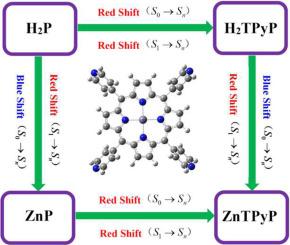Unveiling the mechanism of reverse saturable absorption in zinc tetrapyridyl porphyrins
IF 3
3区 化学
Q3 CHEMISTRY, PHYSICAL
引用次数: 0
Abstract
Reverse saturable absorption (RSA) is one of the important mechanism for a molecule showing optical-limiting property. The experiment found that zinc tetrapyridyl porphyrins (ZnTPyP) exhibit distinct RSA characteristics at both 470 nm and 532 nm wavelengths. To understand the origin of the RSA in ZnTPyP, a theoretical analysis based on the linear-response time-dependent density functional theory(LR-TDDFT) for the ground state absorption (GSA) and the pseudo-wavefunction formulation of LR-TDDFT(PWF-TDDFT) for excited states absorption (ESA) were conducted. Experimentally observed RSA in ZnTPyP are well predicted. It is shown that the transitions of are the origin of the observed RSA feature in ZnTPyP. We found that these excited states transitions exhibit intramolecular charge transfer character and the pyridyl groups play an important role in the charge transfer process. It is also noticed that the pyridyl groups results in a red shift for both the GSA and ESA of porphyrin. In addition, the central zinc atom causes the energy gap between the positions with prominent absorption in GSA and ESA increased. These observations indicate that pyridyl groups and central zinc atom play an important role in tuning the spectral window and strength of RSA in the porphyrin complexes. These observations provide guidance for designing novel optical-limiting materials based on the porphyrin derivatives.

揭示四吡啶锌卟啉的反向饱和吸收机制
反向可饱和吸收(RSA)是分子显示光学限制特性的重要机制之一。实验发现,四吡啶锌卟啉(ZnTPyP)在 470 nm 和 532 nm 波长处均表现出明显的 RSA 特性。为了解 ZnTPyP 中 RSA 的起源,研究人员基于线性响应时间相关密度泛函理论(LR-TDDFT)对基态吸收(GSA)进行了理论分析,并基于 LR-TDDFT 的伪波函数公式(PWF-TDDFT)对激发态吸收(ESA)进行了理论分析。实验观测到的 ZnTPyP 中的 RSA 得到了很好的预测。结果表明,S1→S13,14,15,18 的跃迁是 ZnTPyP 中观测到的 RSA 特征的起源。我们发现这些激发态跃迁具有分子内电荷转移的特征,而吡啶基在电荷转移过程中起着重要作用。我们还注意到,吡啶基会导致卟啉的 GSA 和 ESA 发生红移。此外,中心锌原子导致在 GSA 和 ESA 中吸收突出的位置之间的能隙增大。这些观察结果表明,吡啶基和中心锌原子在调节卟啉配合物的光谱窗口和 RSA 强度方面起着重要作用。这些观察结果为设计基于卟啉衍生物的新型光学限制材料提供了指导。
本文章由计算机程序翻译,如有差异,请以英文原文为准。
求助全文
约1分钟内获得全文
求助全文
来源期刊

Computational and Theoretical Chemistry
CHEMISTRY, PHYSICAL-
CiteScore
4.20
自引率
10.70%
发文量
331
审稿时长
31 days
期刊介绍:
Computational and Theoretical Chemistry publishes high quality, original reports of significance in computational and theoretical chemistry including those that deal with problems of structure, properties, energetics, weak interactions, reaction mechanisms, catalysis, and reaction rates involving atoms, molecules, clusters, surfaces, and bulk matter.
 求助内容:
求助内容: 应助结果提醒方式:
应助结果提醒方式:


